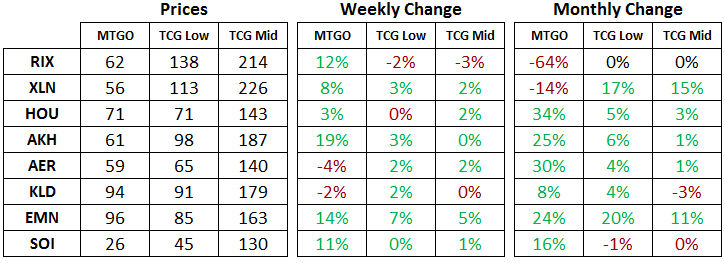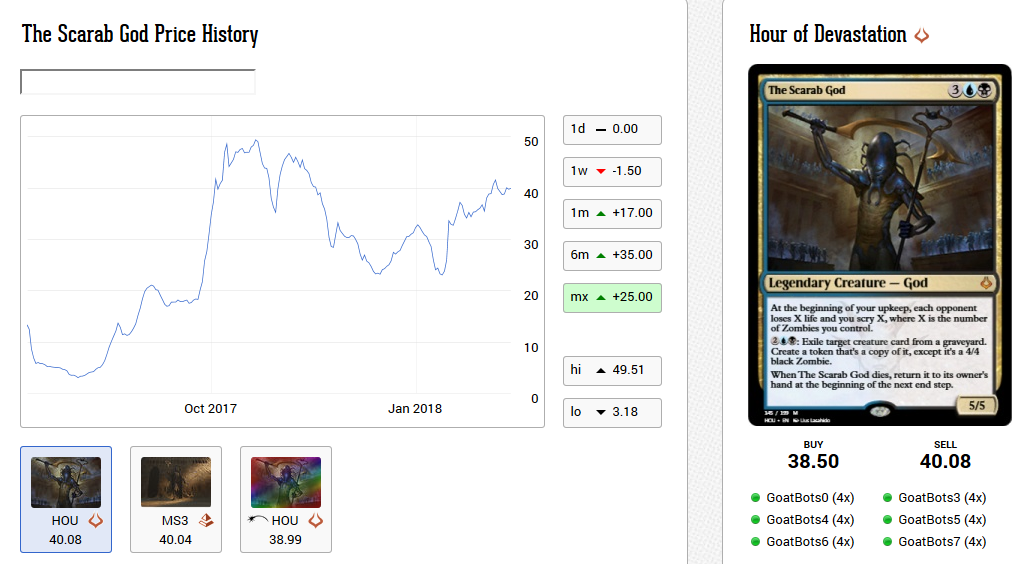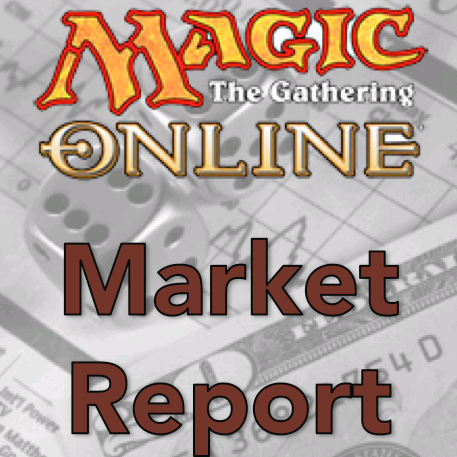Are you a Quiet Speculation member?
If not, now is a perfect time to join up! Our powerful tools, breaking-news analysis, and exclusive Discord channel will make sure you stay up to date and ahead of the curve.
Welcome to the MTGO Market Report as compiled by Matthew Lewis. The report will cover a range of topics, including a summary of set prices and price changes for redeemable sets, a look at the major trends in various Constructed formats and a "Trade of the Week" section that highlights a particular speculative strategy with an example and accompanying explanation.
As always, speculators should take into account their own budgets, risk tolerances and current portfolios before buying or selling any digital objects. Please send questions via private message or post below in the article comments.
Redemption
Below are the total set prices for all redeemable sets on MTGO. All prices are current as of February 12, 2018. The TCGplayer low and TCGplayer mid prices are the sum of each set's individual card prices on TCGplayer, either the low price or the mid price respectively.
All MTGO set prices this week are taken from GoatBot's website, and all weekly changes are now calculated relative to GoatBot's "full set" prices from the previous week. All monthly changes are also relative to the previous month's prices, taken from GoatBot's website at that time. Occasionally, full set prices are not available, and so estimated set prices are used instead. Although Hour of Devastation (HOU), Amonkhet (AKH), Aether Revolt (AER), and Kaladesh (KLD) are no longer available for redemption, their prices will continue to be tracked while they are in Standard.

Modern
I'd be remiss if I didn't start with Modern, the format that is receiving the lion's share of attention in the past month, in particular with the recent addition of two powerful cards: Jace, the Mind Sculptor and Bloodbraid Elf. If you didn't catch the news this week, these cards were removed from the banned list on Monday. Bloodbraid Elf was widely expected to be unbanned at some point, but the first-time addition of the most powerful version of Jace to the Modern format took me by surprise. With a very successful Modern Pro Tour event just in the books and a diverse and popular format, changes to the banned list seemed like a low-probability event.
Regardless of what has happened and whether or not it was predictable, it's up to savvy speculators and players to adjust their expectations going forward. Fortunately, the shakeup of Modern is going to put card valuations in a large state of flux, which is a great environment to be a speculator in. A more static environment is one where the drip of supply from Treasure Chests will overwhelm any short-term price move, making it difficult to speculate on. On the other hand, a format in a state of flux will generate rapid shifts in card valuation as players explore the new metagame.
Right out of the gate, some obvious cards are benefiting, such as the creature lands from Worldwake (WWK). With no ability to interact with in-play creature lands, they are a natural and low cost threat to Jace. As a result, Raging Ravine has tripled in price this week, aided no doubt by the return of Bloodbraid Elf and visions of Jund decks. Celestial Colonnade and Creeping Tar Pit have also jumped in price, with the U/W land piercing the 40 tix level for the first time in three years and the U/B land breaking its downtrend and now sitting at over 8 tix.
Classic Jund decks are looking to reemerge from the wilderness on the back of Bloodbraid Elf, and Tarmogoyf and Dark Confidant have jumped as a result. If that turns out to be the case, then decks that Jund has trouble with, like Tron and Titan-Shift, will benefit. A resurgence in Tarmogoyf and Jund decks also means that Threads of Disloyalty will start showing up in sideboards again. This card briefly spiked to over 4 tix last year as a potential answer to Death's Shadow, but in practice it didn't work out and its price has suffered ever since. At less than 1 tix, Threads of Disloyalty is a great prospect to double or triple in price, and I have been buying a bunch.
Keeping an eye on emerging trends will be useful, but it's also good to remember what has happened in the past. Just before it was banned, players were tinkering with Bloodbraid Elf and Boom // Bust to some success. Unfortunately, the rules update to split cards in 2017 means that Boom // Bust has a converted mana cost of eight and thus Bloodbraid Elf cannot cascade into it. With this interaction now gone due to a rules change, there is very little upside to Boom // Bust so skip over this one if you are thinking about speculating on it.
On the more speculative front, Huntmaster of the Fells and Domri Rade are two cards that have seen play in Modern in the past, but have been largely absent more recently. Sharing the same colours as Bloodbraid Elf is a good start to possibly seeing more play, and Domri Rade in particular has a nice interactions with Jace, The Mind Sculptor and Tarmogoyf. In terms of opposition, Huntmaster of the Fells has some play against Jace with its extra 2/2 wolf when it comes into play and its ability to do damage to opponents when it flips. I have also been buying these two cards for the portfolio.
On a more subtle note, both of the unbanned cards are four casting cost, which means that Inquisition of Kozilek gets worse and Thoughtseize gets better. I don't think this type of information is actionable, but it's worth thinking about how a cards valuation and utility changes as a result of the format upheaval.
Standard
This week in the Standard format, Rekindling Phoenix has caught my eye. Although Kumena, Tyrant of Orazca was initially the most expensive card in Rivals of Ixalan (RIX), the four-casting-cost red mythic quickly took the top spot. Its recent price trend higher is continuing, and I expect that strength to continue. Here's the price chart courtesy of GoatBots.

The market is currently going through the process of price discovery on this card, trying to figure out how valuable it is and what its price should be. But the nature of the MTGO market is that prices tend to shoot much higher than what might be a "fair" value. Thinking deeply about how bots and players interact in the MTGO market will reveal why this is true.
First of all, the bots operate in a competitive landscape where buy and sell prices on individual cards don't have a lot of variation. Bots compete with one another, but really they are setting prices by the change in supply they are observing in their systems. As players buy up cards, if there is no incoming supply to offset the purchases then bots will have to raise prices in order to compensate. The big bot chains like MTGO Traders want to have a complete selection of cards available, and if they don't increase prices in the face of rising demand, then they will rapidly deplete their stock of cards. On the flip side, if players are selling cards, then the bot chains have to start lowering prices to avoid building up their inventory too much. Although there is some difference in how quickly the bots adjust their buy and sell prices, the principle of why they adjust prices is the same. All the bots are interested in doing is maintaining their level of inventory while serving their customers – and collecting the difference between the buy and sell prices of individual cards, otherwise known as the spread.
When this is how you operate, there is no objective fair value price on an individual card that you can point to. All prices are a result of market forces, so it's impossible to set a price that's different from what the market decides the price to be. Even if you think you know that a card is worth 10 tix and should be priced accordingly, prices can fluctuate up and down quite rapidly as the market tries to figure out the price through thousands of individual buy and sell decisions.
With all that in mind, the other feature of the MTGO market that contributes to prices overshooting on the high side is the lack of short selling. In the regular stock market, one has the ability to short a stock by borrowing that company's shares, and then selling those shares on the open market. This is a way that market participants can seek to find the true worth of a company. If people think a stock is priced too high, then they can sell short that stock. On MTGO, there is no way to do this, so even if I ultimately think that Rekindling Phoenix is a 15-tix card, there's no way for me to make that bet.
The only way that a card starts coming down in price is if players and speculators start selling more copies of card than are being bought. Right now, players are still getting their copies of Rekindling Phoenix in order to play Standard. A rising price indicates that the number of buyers is exceeding the number of sellers. And since this card is new, this initial push of demand is the one big push that will cause the price to shoot too high. Looking at the price chart above, we see the price has basically been rising since Rivals of Ixalan (RIX) was released in January. At this point, I doubt we've seen the peak on this card, and I've been a buyer as a result.
We saw a similar effect last year with The Scarab God. The timing was a little different, as the big push of buyers came after Standard rotated, but the impact on price was similar. Have a look at the chart below, courtesy of GoatBots, to see what I mean. Although this card did rise to just under 20 tix by the end of September, the price really took off in early October as Standard rotated, almost hitting 50 tix.

Since almost hitting 50 tix in the fall, the price has been down into the low 20-tix range before more recently recovering to the 40-tix level. If you can point to the true, fair value of this card on the chart, I'd love to hear what price that is. All I can do is surmise that when buyers exceed sellers, the price will rise, which is what is happening right now to Rekindling Phoenix.
Trade of the Week
For a complete look at my recent trades, please check out the portfolio. This week I've been making many transactions in the portfolio, selling off some Modern positions and establishing some new positions in fringe Modern cards. But I have also been looking at the Standard format with the ascendant Rekindling Phoenix in particular catching my eye. I've been buying a few foil copies and a bunch of regular versions. The price looks set to rise into the mid-30-tix range at least. Once the price increases slow down or stop, I will be a seller.






With Entrancing Melody most Snapcaster Mage decks are not going to play Threads. We will have to wait and see if other blue archetypes prefer it, but as it’s more fragile than the sorcery I highly doubt it.
I think being able to steal a goyf on the play for 1UU is quite a bit different than having to wait one more turn and paying 2UU. I don’t think Entrancing Melody completely invalidates Threads of Disloyalty as a result.
There will be a tension between having Entrancing Melody as an all purpose, but slower answer to creatures, while Threads is more targeted and faster. Depending on what you care about in Modern, one could be better than the other, but I don’t know the answer to that question.